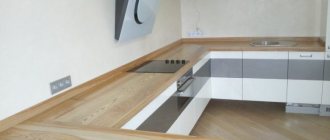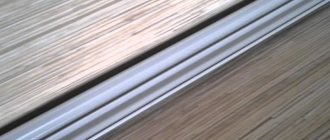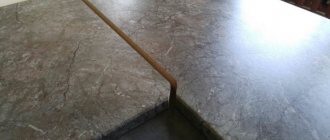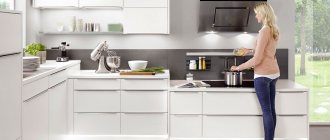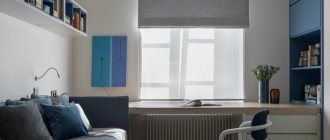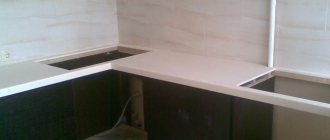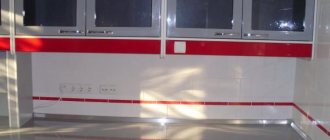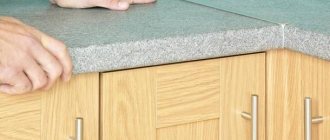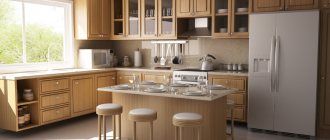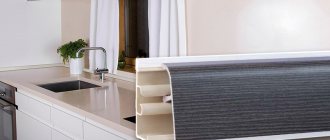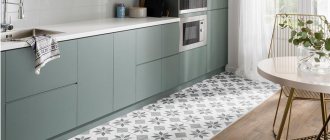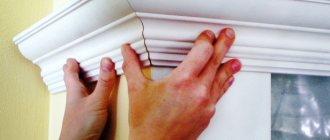The calling card of any renovation is the junction nodes, the way one material or surface passes into another, for example, the joint between a countertop and an apron. The quality of the repair is how well it is done. A kitchen plinth is an element for finishing the junction between the apron and the countertop; another name for it is molding.
There is a huge range of kitchen edges, ranging from budget options made of plastic to expensive ones made of artificial or natural stone. In this material, we will analyze in detail the functionality, what kitchen moldings exist, what their features are, how they fit into the backsplash, how to install them, and whether they are even needed in modern renovations.
Article navigation:
|
Functions of kitchen plinths
The purpose of a kitchen plinth is similar to the purpose of its floor counterpart. The kitchen edge serves for correct joining without a gap between the countertop and the apron, which is used to decorate the working surface of the wall. This element performs the following functions:
- Protecting the seam between the tabletop and the apron from drops and crumbs. It often happens that kitchen elements do not fit tightly against the wall. This occurs due to curvature, deviations from the vertical or horizontal of the load-bearing surfaces. Residues of food and crumbs can get into the resulting gap, which in the future become a source of unpleasant odor. Protection from water is necessary for countertops made of wood and wood-derived materials, such as chipboard, fiberboard, MDF and the like. When exposed to moisture on the open end, the material may swell. If you cover the joint with molding, this will protect the tabletop from contact with water, and it will last much longer.
- The design of a kitchen baseboard can complement the interior of the kitchen and backsplash. Its presence makes the space complete and harmonious. In part, the kitchen edge hides finishing defects, for example, a chip in the tile on the backsplash or a defect on the countertop. If there is a small gap of up to 20mm between the kitchen and the wall, then the molding will close it. It is also indispensable when installing a glass apron: the skinali is aligned with the upper cabinets, and the gap below, usually 2-5 mm, is closed with a plinth.
- lighting can be implemented in the wall rim. There is a large selection of models with space inside for wires and LED strips. Such lighting is used as an additional light source or as an emergency light.
Material - advantages and disadvantages
Skirting boards are made from:
- Polyvinyl chloride (PVC);
- Aluminum;
- Silicone;
- Acrylic;
- Natural stone;
- Natural wood.
The choice of material is not very variable, because the place of use is subject to significant loads: moisture constantly accumulates there, and near the oven and stove the temperature remains high. Plastic and metal, as the most versatile materials, provide protection from external influences. Moreover, when choosing between the first and second, you can sacrifice appearance and get more reliability, that is, choose metal, or make a more “aesthetic” decision at the expense of some functionality. Natural and acrylic stone are, in a sense, rough materials. They are not suitable for fine work, are less versatile and are expensive. In return, the stone has good external characteristics. Wood is a classic that should only be used if the performance characteristics of the furniture will not be affected. Silicone is added to models made from other materials and is rarely used separately.
PVC
PVC skirting boards are highly elastic: the products tightly cover gaps with thoughtful curved shapes and pronounced irregularities. Polyvinyl chloride is resistant to moisture, corrosion, and rotting. Skirting boards made of plastic more easily take the desired shape during production, so there are practically no options on sale without cable channels. The assets of PVC planks include a variety of textures and colors, while there are also products with imitation metal, wood and stone. To all these advantages is added an affordable price: beautiful and high-quality skirting boards are available in all price categories. Installation of plastic slats will not cause any difficulties even for the average person. At the same time, PVC skirting boards have 3 fundamental disadvantages. The most unpleasant is discoloration as a result of exposure to cleaning products. PVC is not very durable and, in addition, does not tolerate extreme temperatures well.
Aluminum
Aluminum products are noted for their heat resistance, functionality, increased decorativeness, ease of care and convenience. They have high strength and resistance to deformation. In addition to the main advantages, purchasing metal skirting boards has several alternative options. Purchase either the molding alone or a modification with colored tape. The finishing coating can be replaced at any time. The surface itself can be simple, polished and embossed, which adds options for different interiors. Even if the baseboard is not included with the set, it will still look organic. You just need to choose a similar color scheme. Aluminum skirting boards have a minimum of “weak points”. These include high cost. In addition, the plank material is more suitable for sturdy countertops.
Aluminum products sometimes darken!
Silicone
The solid version is rarely used. Silicone in baseboards usually acts as a sealant. Silicone edging is present in wood, metal and plastic products. Manufacturers place it either along the edges or inside, next to the groove for the wires. Silicone adheres tightly to the coating and protects the joints from water and foreign objects. At the same time, solid silicone skirting boards are also made from the sanitary version. The special material is endowed with improved qualities in terms of resistance to moisture and mold growth. It has increased adhesion to commonly used materials: wood, tiles, glass, concrete. At the same time, regular and modified silicone does not combine well with granite and other types of stone. The performance of the silicone layer in the baseboard is sometimes let down. Small seams will generally look unsightly.
Acrylic
Skirting boards made from this material will prove useful in areas where dirt accumulates and pests gather. Acrylic prevents unpleasant contamination and prevents the spread of microorganisms, since it has no pores. Acrylic stone was invented a long time ago - 50 years ago, and its relatively low prevalence is explained by the popularity of other raw materials. The material is obtained by processing acrylic resins, mixing them with mineral fillers and pigment inclusions. The main component is usually polymethyl methacrylate. The quality of acrylic directly depends on the concentration of this component, the higher the better. The acrylic stone coating is easy to clean with one movement of the hand, which is why skirting boards made from it are widely used in restaurant kitchens, as well as in medical institutions. Disadvantages include a modest choice of shape and high cost, which increases in direct connection with increasing concentrations of polymethyl methacrylate.
A natural stone
The most expensive of the popular options. Stone baseboards for table tops are small furniture friezes. The key advantages of natural stone are felt already upon contact with this material - it is durable and able to withstand mechanical loads of various types: impacts, exposure to sharp objects, pressure. This is associated with its durability, which is also expressed in maintaining its appearance. Stone planks retain their color and texture for a long time, and are not afraid of moisture, chemical agents and ultraviolet radiation. Stone skirting boards are made in the form of a flat panel, and despite their attractive design qualities, the frieze cannot hide some joints. The wall must be as flat as possible, and this is the main limitation. Channels for wires are rarely made in stone baseboards due to the technological complexity of the process.
Natural wood
Wood lacks most of the benefits of metal and PVC. At the same time, the products last more than 10 years if treated with compounds against fungus, mold, insects, aggressive chemicals, ultraviolet radiation, and moisture. At the same time, fire protection will not hurt. The external characteristics of wooden products are worth spending time searching for a well-processed option or carrying out independent manipulations. Aesthetic qualities are ideal for an expensive interior. Wood has become widespread due to its environmental friendliness and thermal conductivity, and these are two more arguments for purchasing wooden plinths. The variety of textures, in turn, helps designers realize new ideas. In contrast to all this is the cost and the total number of shortcomings. Wood rots, swells from water, and loses its integrity at the ends.
Types of wood used:
- oak;
- beech;
- ash;
- pine.
Shape and size of kitchen plinth
The form of the side is developed by the designers of the manufacturer. When choosing the right option, you should pay attention to compliance with the style of the kitchen. Based on their shape, kitchen plinths can be divided into several types:
Triangular is the most common type of kitchen molding, which has become a classic. A product of this shape has an internal right angle, on the sides of which there are holes for fastening to a tabletop or wall. Hypotenuse - the front strip has a decorative surface and snaps into place after fixing the internal fastening part. Skirting boards of this shape can be made from any material.
Rounded - a type of triangular, which also has an internal right angle. The front, decorative part is convex and rounded.
Square and rectangular - a stylish option for a kitchen in a modern design. As a rule, aluminum products have such a variety of shapes.
Flat ones are a kind of compromise between a full-size plinth and its absence. It is used when it is necessary to close a small gap of a couple of millimeters between the tabletop and the skin. At high heights they can be used instead of an apron.
Curly e (fillet) is another type of triangular skirting boards. They are characterized by figured elements on the decorative part: bends, grooves and protrusions. Most often found among wooden sides.
Kitchen edges are sold in lengths up to 5 meters. The exact size can be obtained from the supplier. For successful installation, they must be purchased with a reserve so that there are as few joints as possible on the baseboard itself.
The width and height of kitchen moldings may vary significantly between different models. For example, there are plastic skirting boards 5mm high and 30mm wide.
Types of skirting boards by design
Skirting boards have different design solutions. Their configuration depends on this. The list of fastening and connecting elements may include:
- external and internal, left and right corners;
- connecting strips;
- self-tapping screws;
- plugs left and right.
The configuration depends on the configuration of the countertop design line. The removable outer strip can snap into place or fit into grooves on the inside of the baseboard. Also, its body can be solid. Installation of the baseboard is carried out using methods recommended by the manufacturers.
Cast
To order, you can make a one-piece plinth that exactly matches the line where the kitchen unit joins the wall. This is an advantageous solution in all respects, since it ensures tight sealing of gaps.
Expensive kitchen furniture is equipped with such products. Most often they are made of steel, specially treated wood or marble.
Universal
Universal kits consist of several strips, connecting and fastening elements. Such skirting boards are mounted on surfaces of different configurations. The standard length of the planks is 2.8-3 m. Installation of the plinth begins with cutting them into pieces of the required length.
Choosing a kitchen plinth for the skinali
If you are the happy owner of a custom-made kitchen, then most likely the kitchen plinth was included in the project by the designer. This means that your furniture set already has a border for the apron. It's possible that for some reason you want to replace the entire baseboard or countertop and just need new molding.
Below are tips for choosing a kitchen plinth so that it copes with its functions, fits harmoniously into the interior and maintains an excellent appearance for a long time.
Match the color and material of the countertop
One approach to choosing a plinth says: the side should be taken from the same material and color as the tabletop. For example, a stone countertop - stone plinth, wooden - wooden, laminated - plastic in color. If you couldn’t find one from the same material or your budget is limited, then you can look for the most suitable option among plastic moldings, among which there is the largest selection of colors.
For kitchen fittings
The second approach says: the baseboard should be matched to the color of the fittings in the kitchen, sink, railing and other accessories. For example, a gold rim will go well with gold handles and rails, and an aluminum version will go well with a matte stainless steel sink.
General Tips
When ordering a kitchen set along with a countertop, immediately select the appropriate baseboard; this will allow you to order them together in one batch and there will be less likelihood of color differences.
For each type of side there is a recommended installation method, which is better to find out in advance. Some models are glued, some are screwed to the tabletop with self-tapping screws, and some are screwed to the wall. In addition, there are combined installation methods: on sealant and on furniture nails at the same time.
If there is a large gap between the apron and the countertop, you should carefully consider the width of the kitchen plinth - it should cover this gap with a small margin so that it can be fixed to the work surface. The wider the gap, the larger the width of the plinth.
When using a gas hob, it is better to use heat-resistant baseboard options.
When installing a glass apron on a countertop made of natural or artificial stone, the best result is achieved when the plinth is placed after the apron. The order is as follows: installation of the countertop - installation of the apron - installation of the baseboard.
other methods
There are several options for combining an apron and a kitchen countertop, so each case is individual. Plastic plinth is considered the simplest and most budget option. It is easy to install, so you can even do the installation yourself. There are more interesting options that will not only protect the tabletop, but also make the interior more harmonious and thoughtful:
- Skirting boards made of artificial or decorative stone can be ordered directly from the furniture manufacturer. Such a border will become a smooth continuation of the tabletop. This method is great if the surfaces are of different colors and you want to make a smooth transition. When choosing such a border, you need to take into account that it will not close the large gap between the wall and the furniture. Therefore, it can be installed if the wall is completely flat and the kitchen set is installed close to it.
- To connect the furniture with the apron, you can use a high side of 15 cm. It is made of practical material that will protect the wall from splashes and dirt. In this case, it is recommended to choose a tabletop in the same color as the side. This option is suitable for plain furniture and an apron. In order to add a “zest” to the interior, carved borders can be used.
- A clear or colored sealant will help join two completely different materials. In this case, the furniture must initially be installed, after which the apron should be laid out. This method is quite complex and requires great skill from tilers, because laying the tiles must be carried out as carefully as possible so as not to damage the set and ideally adjust the apron to its dimensions.
view album in new window
Apron without baseboard
After reading all of the above, the reader may think: there are so many complexities and nuances with the plinth - maybe without it at all? Yes, this is possible, but subject to a number of conditions:
- The tabletop must be installed strictly level, the permissible deviation is no more than 0.5mm
- the joint between the countertop and the apron in the kitchen should not exceed 1mm
What functions does a kitchen ledge perform?
- This element is used to block the gap between the table, countertop, wall - crumbs, moisture and more will not get there.
- The edge is installed to hide the unevenness of the edges of furniture or tabletops - this is how it plays a decorative role. Decorative plinth makes furniture visually more beautiful.
- Extending the life of furniture in the kitchen - this option is related to the first one, since the baseboard closes the gaps from moisture and grease. If various liquids and chemicals constantly get into the gaps between the work surface and the wall, the furniture may gradually collapse, and mold and mildew will form.
- The baseboard visually supports the style of design and finishing of the kitchen. It is important to choose the material, texture, color, and size of the product to match so that it does not fall out of the design.
- Behind the side you can hide wires and communications used to connect equipment.
How to install a kitchen plinth?
You can install kitchen plinths yourself. The process is not difficult if you approach the matter thoughtfully and without unnecessary fuss.
Procedure:
- Check the presence of all elements of the kitchen molding in the required quantity and tools: whips, corner, end and joining elements (if necessary), sealant, fasteners (screws or nails), tape measure, pencil, hacksaw or miter saw, screwdriver (if installed on self-tapping screws) , hammer (if installed on nails), sealant gun.
- Measure the required length of the plinth, taking into account the joining and end elements.
- Cut to the required length. The rule here is: measure seven times, cut once. The extra 10mm can be cut off, but it will not be possible to increase it.
- Apply sealant to the joint between the countertop and the apron.
- Install the side on the sealant and secure it using a suitable method: screws, nails, staples, etc. It is important that when fixing the baseboard, it must fit snugly to the countertop and wall.
- Similarly, assemble the side along the entire length of the kitchen and install corner, end and connecting elements.
Installation
Installation of skirting boards begins with preparing the surfaces. They should be free of dust and debris. If plastic products are installed, the countertop must first be degreased using white spirit. This is followed by instructions on how to install the baseboard on the kitchen countertop. Regardless of the material used to make the products, the following steps are performed:
- If the plinth is purchased disassembled, connect the inner and outer strips.
- Check whether the set is installed correctly and, if necessary, align it along the wall.
- Choose a mounting location. Optimally this is a countertop.
- Set internal and external corners.
- Using a tape measure, measure the distances between them, taking into account the entry of the strips into the grooves of the connecting elements (5 mm).
- Measure the required lengths of the segments and place marks on the plinth.
- The strips are cut with a hacksaw.
- 5 mm of decorative insert is cut off from the left and right sides of each piece of plinth. This distance is required to enter the outer and inner corners. If fastening with self-tapping screws is chosen, the decorative strips are not inserted back after trimming.
- Place the inner part of the plinth into the grooves of the connecting elements.
- Attach each plank to the countertop and/or wall using self-tapping screws.
- Install external face strips.
If installation is carried out using glue, it is applied before installing decorative strips on the tabletop or the lower part of the assembled baseboard. The final stage of work is the installation of end caps.
There are several important points in the design of the line where the kitchen unit joins the wall. The first is to take the measurements correctly. It will be possible to correct the error only if materials are available. Therefore, inexpensive plastic or aluminum skirting boards are purchased with a reserve.
Another important point relates to the installation of plastic products. For a tighter connection to the wall and table top, the side edges are treated with sandpaper. This will make the surfaces rough, and the glue will fill all the microcracks.
There is one more rule for installing skirting boards with glue. After pressing the planks to the surfaces on which they are fixed, it is necessary to immediately remove the squeezed out adhesive. This is done using any object with smooth edges. It is not recommended to use a stationery or other knife, as scratches may appear on both the baseboard and the tabletop. If everything is done correctly, the work area in the kitchen will be decorated beautifully and reliably.
With aluminum base
In terms of the ratio between price and quality, this option is recognized as one of the best. The surface is textured or polished. Some models have interchangeable color strips, which are sold separately in roll form.
The tape is easy to tear off and replace with new elements when the need arises. The color is chosen to match the kitchen units themselves or the countertops.
Aluminum skirting boards for kitchens also have a whole range of advantages:
- Appearance.
- Universal purpose.
- Easy surface cleaning.
- Easy installation.
- Resistance to variable humidity and ultraviolet radiation.
- Heat resistance. The molding is installed directly next to the household appliances themselves.
- Protection from mechanical damage.
The high cost is considered a negative side, but the costs are offset by the benefits.
Ceramic tiles or porcelain stoneware as a material for a kitchen apron
A traditional, familiar option for wall decoration in the kitchen. Has a number of advantages:
- excellent resistance to moisture and high temperatures;
- withstands the effects of acids, alkalis, household chemicals;
- strength, durability;
- easy to clean from any stains, the ability to use abrasive cleaning agents;
- a huge range of sizes, colors, decorative patterns.
Disadvantages include the complexity of installation and the need to purchase additional materials - tile adhesive, corners, grout. Replacing old tiles will also require some work.
Subtleties of installing the side
Installation work is carried out by the same specialists who install kitchen units. It is not recommended to refuse to install a plinth, since it provides many protective options and completes the design of the furniture.
But installation is also possible on your own, if you do not mount the board together with the furniture:
- Having purchased the product, you need to make sure that all the parts are included (bolts, special gaskets).
- It is worthwhile, before installation, to use a sealant to treat the edge of the tabletop, the joint.
- You will need a tool for cutting the baseboard, depending on the type of material. For example, a regular hacksaw is used for MDF, chipboard, aluminum; for ceramics, a special machine is used.
- Take accurate measurements to cut the right piece for a specific installation location.
- Fastening is carried out using a drill or other tools - depending on the material.
- The final stage is installing the plugs.
Note! The length of the side strip should be slightly shorter than the length of the tabletop.
What does the kitchen edge consist of?
The design is mostly standard. Let's look at an aluminum model as an example:
- Fasteners are the main part that is installed first;
- Decorative element;
- Caps and corner parts;
- Jumpers.
The main part will not be visible after installation - the strip completely covers it during installation. To ensure tightness, the package includes a silicone liner (usually for aluminum moldings, less often for plastic).
When buying a plinth, consider the size of the gap. The standard height of the molding is about 2-3 cm, more - up to 10 cm.
Professional installation is preferable. If you decide to replace the set, it is better to immediately install the tabletop baseboards to protect the gaps.
There are two ways to secure the molding: using special glue or using self-tapping screws or bolts. Self-adhesive skirting boards are on sale.
Rules for calculating the height of the apron based on materials
What this zone will be like depends not only on the configuration of the kitchen unit, but also on the material used.
For example, if you are laying tiles , then to the actual height of its several rows you need to add another 0.5-1 centimeter for the seams. The result will be just over 60 centimeters, and the excess can be safely hidden behind the upper and lower cabinets. Or cut it off.
When performing these works, take into account the nature of the pattern on the ceramic surface: the texture should not be abruptly interrupted - it looks ugly. Therefore, it is worth increasing or decreasing the apron by a couple of centimeters if you cannot cope with this task in any other way.
Skinals can be purchased ready-made or made to order. Unlike tiles, glass is not divided into segments, and therefore you can design an apron with a convenient height ranging from 50 to 60 cm.
If you are laying MDF or PVC panels , then it is best to immediately select fragments with a height of 20-30 cm - you will get exactly 3 and 2 rows, respectively. Or go from the opposite direction and design the height a little higher than the standard one.
Which apron material is the most durable, which is the most fashionable, and which is timeless - you will learn from our article.
